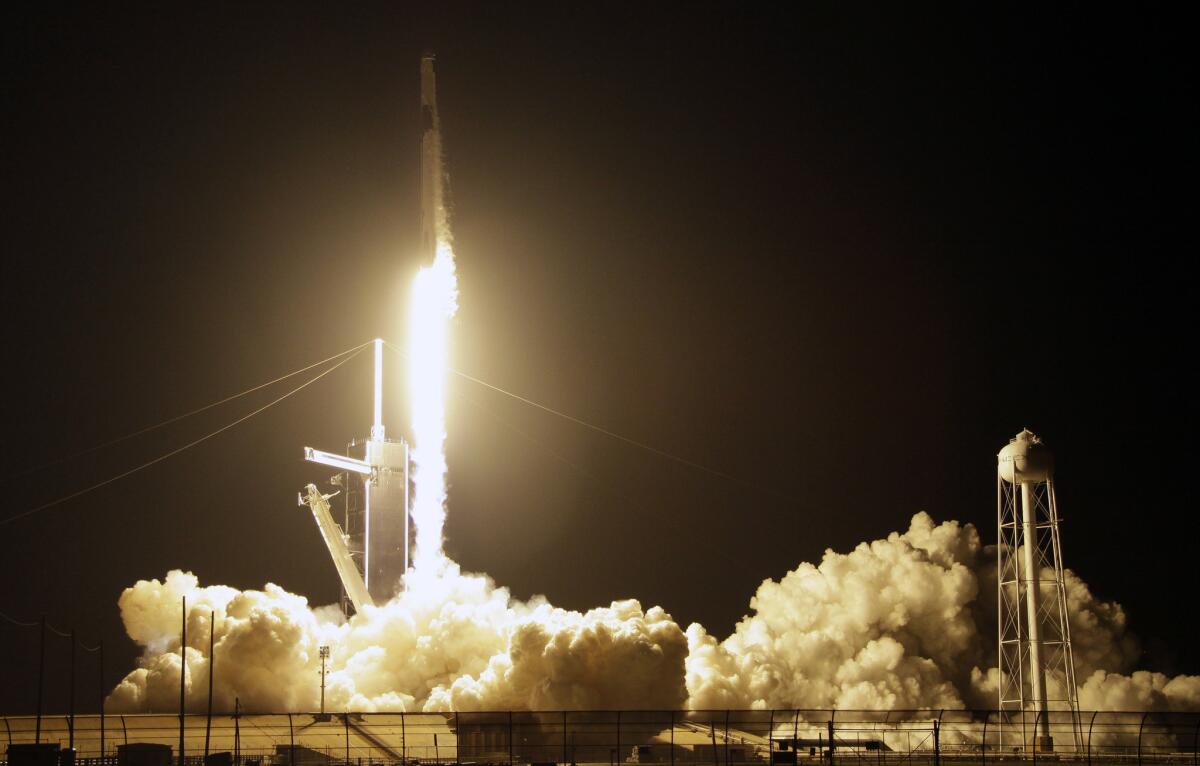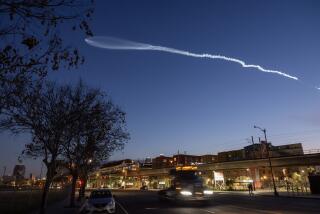SpaceX successfully launches astronaut capsule without crew in landmark test mission

- Share via
It was 1 a.m. Pacific time on Saturday, just an hour after SpaceX launched its Crew Dragon capsule for the first time, and Elon Musk was drained.
Calling the NASA test launch “super stressful,” the chief executive later recalled how SpaceX’s first three attempts at launching its early Falcon 1 rocket ended in failure.
If Falcon 1’s fourth launch had not worked, “that would have been it for us,” Musk said.
But that launch was a success, and this time around Musk had good fortune on his first attempt to launch a space capsule.
The unmanned Crew Dragon, which is designed to carry astronauts to the International Space Station, lifted off on a SpaceX Falcon 9 rocket at 2:49 a.m. local time Saturday from the same Florida pad where Apollo and space shuttle missions once launched.
The capsule, with some 400 pounds of cargo and a mannequin passenger named Ripley, deployed from the rocket’s second stage about 11 minutes after liftoff, sending it on a trajectory to the space station, where it is scheduled to dock early Sunday morning. The Falcon 9 rocket landed on a floating sea platform in the Atlantic Ocean about 10 minutes after liftoff.
With Friday night’s launch, Musk’s Hawthorne company is now one step closer to ferrying NASA astronauts to the station and accomplishing SpaceX’s longtime goal of flying humans to space.
“It’s been 17 years to get to this point,” he said during a post-launch news conference Saturday. “We have to dock with [the] station, we have to come back, but so far it’s worked. We’ve passed some of the riskiest items.”
The launch came as Musk juggled challenges at his other company, Tesla Inc. A few days earlier, he announced that the Palo Alto electric-car maker would start taking orders for its Model 3, a long-promised $35,000 vehicle, but would also be closing many of the company’s retail outlets. The company’s shares fell sharply on the news.
Musk was tweeting with Tesla owners about the company’s plans shortly before Friday’s SpaceX launch. About 20 minutes before liftoff, he signed off for a bit, saying, “Need to get back to SpaceX launch control.”
Friday’s launch was the first test flight for NASA’s commercial crew program, a public-private partnership involving SpaceX and Boeing Co., which have contracts worth a combined $6.8 billion to build separate craft to transport astronauts to the space station. Since the space shuttle program ended in 2011, NASA has relied on Russia to carry its astronauts to the station.
SpaceX and NASA employees joined forces Friday night to monitor the launch, which allowed the two groups to work together ahead of the next test mission, which will have two NASA astronauts aboard. That launch is set for no earlier than July.
“From our standpoint, this is what you want to see,” said Doug Hurley, one of the two NASA astronauts who will be on that crewed test flight. “You want to see the team hitting its stride as we get ready to put people on these things.”
Boeing’s first flight test of its CST-100 Starliner capsule without crew aboard is set for April, with a crewed test expected no earlier than August.
Already, NASA relies on SpaceX and Northrop Grumman Corp. to ferry supplies to the space station in uncrewed capsules. SpaceX has launched 16 resupply missions so far with its Dragon cargo capsule.
The Dragon cargo capsule’s design has a few significant differences from its crew compatriot. For one, the crew capsule will dock autonomously at the space station, while the cargo capsule is grappled by a robotic arm. Musk said Saturday that the Crew Dragon’s nose cone opened as expected, which will allow the capsule to dock.
The crew capsule will also have the necessary life-support systems on board, but before SpaceX flies humans, it will have to comb through the data with NASA from Friday’s flight to make sure all of the capsule’s systems performed as expected.
They will also be using the sensors on Ripley — named after the fictional character in the “Alien” film series, a classic Musk touch — to test the forces, acceleration and environment that astronauts would experience aboard the Crew Dragon, SpaceX executive Hans Koenigsmann said Thursday. Ripley also has a microphone behind her ear, allowing ground crews to hear what she hears.
The systems on this uncrewed Crew Dragon capsule are “very similar” to the ones that will be on the next crewed flight, Koenigsmann said, but “there is still some work to be done.” The company is building another capsule for the launch that will carry astronauts. The capsule that launched Friday will be reused for an in-flight abort test currently set for June.
The company will have to work through several outstanding issues noted prior to Friday’s flight, such as understanding the full behavior of the pressure vessels in the Falcon 9 rocket’s second stage.
Deformities in one of the vessels, which help maintain pressure in the rocket’s liquid oxygen tank, were implicated in a 2016 launch pad explosion that destroyed a Falcon 9 rocket and satellite.
SpaceX and NASA will also continue testing the capsule’s parachute system and try to rectify a problem with the capsule’s thrusters, which did not operate optimally at certain temperatures during testing, NASA said Thursday.
The space agency’s new commercial partnerships represent a major shift in how NASA does business.
For decades, the agency owned the vehicles that carried its astronauts to space, and contractors built the craft with heavy agency input. In the commercial crew program, NASA released a broad set of requirements for astronaut safety, but companies were free to design their craft to meet those standards. NASA then worked closely with SpaceX and Boeing to offer expertise and resources during the development process.
“This was kind of like co-designed by SpaceX and NASA in the sense that there was so much interaction and feedback,” Musk said Saturday. “This was a joint effort, really.”
Still, Musk said he was not celebrating yet. The Crew Dragon capsule must still dock with the space station early Sunday — following the autonomous procedure SpaceX has never before done — and then it is due to leave the space station and splash down Friday in the Atlantic Ocean, where a recovery ship will pick it up.
Musk said Saturday that the capsule’s hypersonic reentry to Earth is “probably my biggest concern.” Crew Dragon has escape thruster pods integrated into the capsule’s side, making it less smooth than its cargo counterpart, he said.
Even so, Garrett Reisman, a former NASA astronaut who flew on three shuttle missions and served as former director of space operations at SpaceX, said seeing the capsule lift off was very emotional.
“There was an enormous amount of preparation and consultations with NASA, and of course all the engineering effort,” said Reisman, now a USC astronautical engineering professor with an advisory role at SpaceX. “Then to see it fly, I’d be lying if I didn’t say I had a huge lump in my throat when it took off. Just really wonderful to see.”
Twitter: @smasunaga
More to Read
Inside the business of entertainment
The Wide Shot brings you news, analysis and insights on everything from streaming wars to production — and what it all means for the future.
You may occasionally receive promotional content from the Los Angeles Times.











